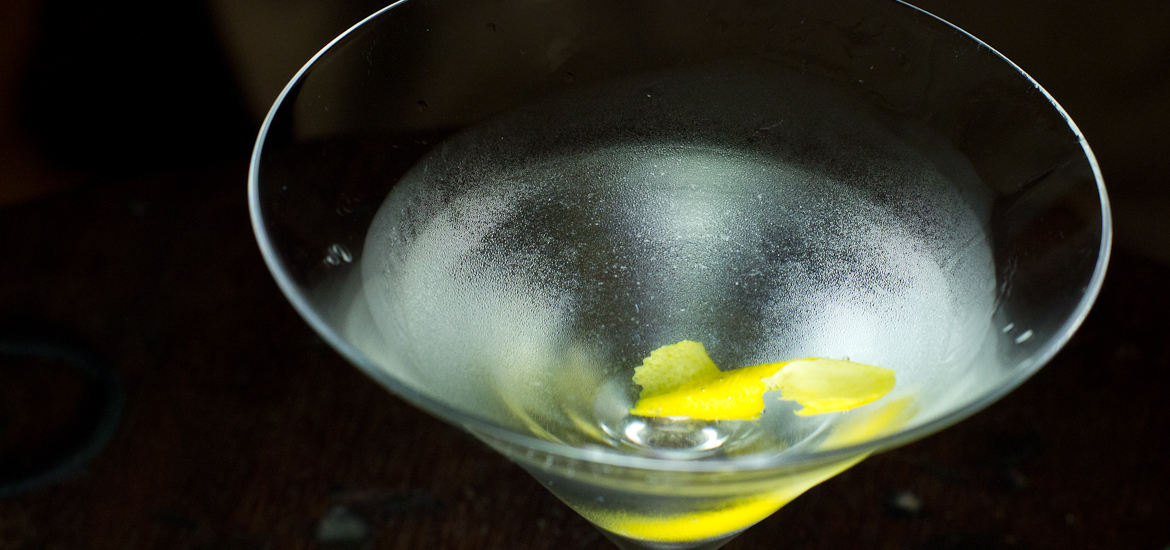Your first gobful of martini should brace you even as it slams you. You should gasp. Your mouth should thrill, your blood should pump, your heart should sing.
Not an ounce of this liquid should be in any goddamn way a compromise. It must be utterly intense. It should not quench your thirst; it should quench your desire.
The disinterested, thuggish punch of the gin. Wrapped in the shimmering gossamer of the botanicals, mitigated (but so slightly, so slightly) by the sweet yield of the vermouth. The lingering scent on the boxer’s glove.
And — just when you think you’ve got your tastebrain around it all — the savage perfume of the lemon or the oily, dirty smear of the olive.
That. That, my friends, is a martini.
Let it never be less.
Essential rules for making the Perfect Gin Martini
Right. In many respects, I am open-minded. But open-mindedness stops here. Because there are three rules — no, scratch that, there are three commandments. Disobey them and you will not have a perfect martini; you’ll have a shit drink unworthy of the name. With them, you’re well on your way to the promised land.
- Everything must be as cold as you can humanly get it. I mean everything. Possibly including your soul.
- Your gin and your vermouth should be of good quality — because they are literally all you are tasting, here.
- You do not make the perfect martini in a hurry.
So, first up, let’s talk temperature. You’re making martinis? You’d better have lots of ice. Big solid chunks of ice, please; none of your crushed rubbish. And every single ingredient of the drink should, at bare minimum, be fresh from the fridge. I keep my gin in the freezer. I also keep my martini glasses in there, so long as Amy hasn’t filled it up with goddamn peas (three bags, people, three bags.). Were it not for discomfort and physical impossibility, I’d keep the hands that are ultimately going to hold the martini in there. You understand?
Now, ingredients. Our perfect martini is not the place for your bargain basement, paint-stripper gin. Because gin is the sodding main ingredient, here. It is front and centre. If you only have mediocre gin, wise up and make a different drink. And much the same goes for vermouth. It’s relatively inexpensive, in the scheme of things, and you can keep a bottle of it in the fridge for a few weeks (usefully, it doubles up as an excellent cooking wine).
I’m not going to tell you which gins and vermouths to use. There are bloody hundreds of ’em out there, and trying new combinations is pretty interesting. But if you’re looking for a starting point, I suggest you could do a lot worse than a classic unpretentious and juniper-led gin like Plymouth (which is the house choice at the marvellous Dukes Hotel bar) or Tanqueray. For vermouth I typically use Noilly Prat (£12, Ocado), which is splendid stuff, but the Wine Society’s Chambery (£8.95, The Wine Society) is a fine alternative.
And, finally, speed. This is where I used to go wrong, making martinis. I went at it like a madman. But, no. Making a perfect martini requires patience. You actually want (you see) a very little of that ice to melt — a little water to bind together your gin and vermouth. Just enough to smoodge them together a bit. And you get this by taking your time.
How to Make the Perfect Martini

Get your cocktail mixer (or a jug/large mixing glass, if you don’t have one) and fill it full of ice. A lot of ice, in big cubes.
Pour your vermouth over the ice and stir gently. I’d suggest a ratio of 1 part vermouth to 4-5 parts gin — which is dry but not show-offy (my own view is that the vermouth is there for a reason, and once you get to 1:15 ratios and the like, you’re really not getting the benefit of it). However, this is for you to toy around with.
Take your gin from the freezer (don’t hurry, don’t hurry) and pour that in, too. Stir once again, gently but firmly — you want to move the ice and liquid around thoroughly, but you don’t want to smash up the ice cubes and add shards of ice to the liquid. When you’ve given it a decent long stir, leave it to settle.
Put away your gin. Put away your vermouth. Refill the ice tray(s) you emptied and put them in the freezer for tomorrow evening. Take out your (refrigerated) olives, and thread a couple of them onto a cocktail stick. Or (if you’re of a citric persuasion) take a slice of rind from your lemon, trying — if you can manage it with your hands shaking like that, old boy — not to cut off too much pith. And this all should be conducted at the leisurely pace befitting a suave martini-drinker such as yourself.
Thirsty yet? Too bad. Stir again. Go for a little walk to the sitting room and back, why don’t you? Entertain your guests with an offhand fragment of your debonair wit (or just mutter to yourself, you massive, booze-dependent loner). Then come back.
Take your martini glasses out of the freezer. If you’ve taken the lemon route, you should give the rind a good squeeze-twist, holding it over the glass for which it is destined, before you add it to the glass. The objective is to release those delicious citric oils. Or if you’re having olives instead of lemon, chuck ’em in.
Stir the gin & vermouth one last time, then strain the precious liquid into the glass. You are now in possession of the perfect martini.
Serve. Immediately. This is the only time at which you actually should hurry.
Bask in the admiration of your peers. Get working on the second one.
